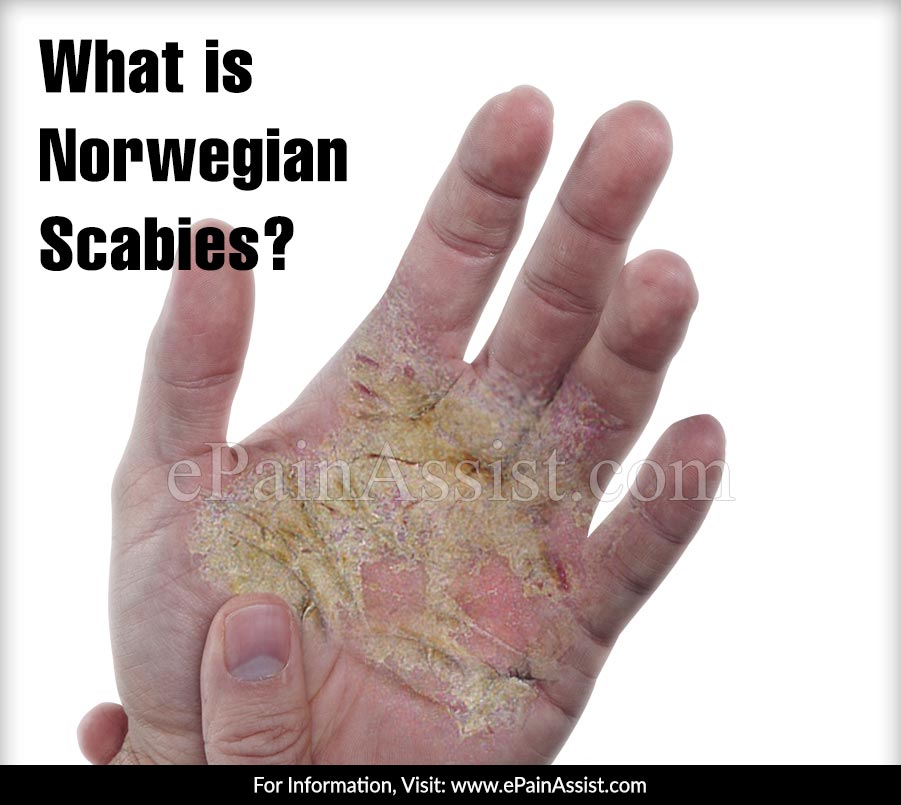About Scabies
Scabies is one of the most common contagious diseases which results in a persistent and irritating itch that starts out slowly but intensifies over time. The tiny itch mites that cause this condition are called Sarcoptes scabiei. The itch mites are so small in size that they are not visible to the naked eye, but can only be seen with the help of a microscope. They burrow into the skin of the infected humans and lay their egg underneath the epidermis. Scabies produces little bumps and blisters in the webs between the fingers, and in the folds of the skin on the wrists, elbows, groin, knees, breasts, penis and buttocks. This infection spreads through direct skin contact with a scabies patient. Scabies is also an extremely common sexually transmitted disease. So, family members and sexual partners of scabies patients face the greatest risk of contracting this disease. Wondering what is Norwegian scabies and how is it different from classical scabies? Given below is a detailed piece of read to help you understand Norwegian scabies, better.

What is Norwegian Scabies?
Norwegian scabies is nothing, but a very severe form of scabies. Also termed as crusted scabies, Norwegian scabies specifically refers to a severe form of scabies. It is called Norwegian scabies since this condition was first described in Norway in the mid-19th century. People who have a highly compromised immune system are t higher risk for developing Norwegian scabies. The condition of scabies patients can worsen and become more severe resulting in Norwegian scabies. Young children, seniors, pregnant women, people with disabilities, brain disorders, Down’s syndrome, HIV or AIDS, transplant recipients, individuals on steroid medicines and ones undergoing chemotherapy are most prone to Norwegian scabies. People suffering from crusted scabies may not display the usual symptoms of scabies like the characteristic rash or itching.
What are Complications Associated with Norwegian Scabies?
Norwegian scabies can lead to other, more life-threatening situations. Since a person suffering from crusted scabies already has a compromised immune system, the tendency of their skin to flake off puts them at a high risk of contracting bacterial diseases like streptococcal, staphylococcal, impetigo or cellulitis.
Diagnosis and Treatment for Norwegian Scabies
People suspected of having Norwegian scabies should get examined for the presence of mites, mite eggs or mite fecal matter. This can be done by testing the individual’s skin scraping. Scabies can be treated with specific chemical insecticides known as scabicides, which can be applied on the body in the form of creams or lotions. Certain antibiotics may also need to be administered to manage Norwegian Scabies. Since crusted scabies can be tough to heal, the entire treatment process may need to be repeated to get rid of Norwegian Scabies. Keratolytic agents can be used by the patients to remove the affected skin. They can also use the medication called permethrin for over 6 weeks to effectively treat Norwegian Scabies. Another possible treatment for Norwegian scabies is Ivermectin. However, some patients have reported resistance to this medication.
Prevention of Norwegian Scabies
Norwegian scabies is an extremely contagious condition and is spread through skin-to-skin contact. To minimize the chances of spreading Norwegian scabies, patients suffering from this disease should not share their bedding, clothes, towel, sheets, and other personal items with others. The areas which the patient visits should be carefully vacuumed to minimize traces of Norwegian scabies. It is very important that the patient is treated immediately to reduce the risk of spreading Norwegian scabies.
Classical Scabies v/s Norwegian Scabies: Primary Differences
Norwegian scabies is different from normal scabies where in Norwegian scabies; the body’s immune response to itch mites is not strong enough. This allows for the infestation of the body with hundreds or thousands of these mites. Crusted scabies or Norwegian scabies mostly affects people with a compromised immune system and is generally observed in seniors, mentally or physically disabled individuals, and in patients with lymphoma, AIDS, or other conditions which reduce the effectiveness of the immune response. The lesions of Norwegian scabies are extensive and can spread all over the body. The knees, elbows, scalp, palms, and soles are the most common sites for origination of the Norwegian scabies rashes, and these scaly areas eventually start looking like warts. In Norwegian scabies, the fingernails thicken and get discoloured, and there is hardly any itching in this form of scabies. Norwegian scabies is specifically dangerous because the lesions often give way to the development of secondary infections, caused by bacteria like Staphylococcus. Both types of scabies can be treated with topical permethrin cream and the oral medication, Ivermectin. But, while regular scabies is generally treated with one of these medications, Norwegian scabies can require both oral medications and multiple applications of a scabicides cream.
- Mayo Clinic – Scabies Overview: https://www.mayoclinic.org/diseases-conditions/scabies/symptoms-causes/syc-20377383
- Centers for Disease Control and Prevention (CDC) – Scabies Information: https://www.cdc.gov/parasites/scabies/index.html
- DermNet NZ – Crusted Scabies (Norwegian Scabies): https://dermnetnz.org/topics/crusted-scabies/
Also Read:
- Scabies: Causes, Signs, Symptoms, Investigations, Treatment, Home Remedies, Prevention
- How Does Scabies Spread?|Causes, Treatment, Home Remedies, Prevention of Scabies
- How Do You Get Scabies, Know its Home Remedies, Prevention
- What is Scabies?|How is it Transmitted|Is Scabies Contagious?
- How Long Does Scabies Last For?
- 4 Natural Ways To Treat Scabies During Pregnancy
